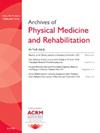The Effects of Near-Infrared Phototherapy Preirradiation on Lower-Limb Muscle Strength and Injury After Exercise: A Systematic Review and Meta-analysis
IF 3.6
2区 医学
Q1 REHABILITATION
Archives of physical medicine and rehabilitation
Pub Date : 2025-01-01
DOI:10.1016/j.apmr.2024.04.013
引用次数: 0
Abstract
Objective
To assess near-infrared preirradiation effects on postexercise lower-limb muscle damage and function and determine optimal dosage.
Data Sources
PubMed, Embase, Cochrane Library, EBSCO, Web of Science, China National Knowledge Infrastructure, and Wanfang Data were systematically searched (2009-2023).
Study Selection
Randomized controlled trials of near-infrared preirradiation on lower-limb muscles after fatigue exercise were incorporated into the meta-analysis. Out of 4550 articles screened, 21 met inclusion criteria.
Data Extraction
The included studies’ characteristics were independently extracted by 2 authors, with discrepancies resolved through discussion or by a third author. Quality assessment was performed using the Cochrane risk of bias tool and the Grading of Recommendations, Assessment, Development, and Evaluation System.
Data Synthesis
In 21 studies, near-infrared preirradiation on lower-limb muscles inhibited the decline in peak torque (standardized mean difference [SMD], 1.33; 95% confidence interval [CI], 1.08-1.59; p<.001; increasing 27.97±4.87N·m), reduced blood lactate (SMD, −0.2; 95% CI, −0.37 to −0.03; p=.272; decreasing 0.54±0.42mmol/L), decreased creatine kinase (SMD, −2.11; 95% CI, −2.57 to −1.65; p<.001; decreasing 160.07±27.96U/L), and reduced delayed-onset muscle soreness (SMD, −0.53; 95% CI, −0.81 to 0.24; p<.001). Using a 24-hour cutoff revealed 2 trends: treatment effectiveness depended on power and energy density, with optimal effects at 24.16 J/cm2 and 275 J/cm2 for energy, and 36.81 mW/cm2 and 5495 mW/cm2 for power. Noting that out of 21 studies, 19 are from Brazil, 1 from the United States, and 1 from Australia, and the results exhibit high heterogeneity.
Conclusions
Although we would have preferred a more geographic dispersion of laboratories, our findings indicate that near-infrared preirradiation mitigates peak torque decline in lower-limb muscles. Influenced by energy and power density with a 24-hour threshold, optimal energy and power densities are observed at 24.16 J/cm2, 275 J/cm2, 36.81 mW/cm2, and 5495 mW/cm2, respectively. Laser preirradiation also reduces blood lactate, creatine kinase, and delayed-onset muscle soreness.
运动前近红外光疗对下肢肌肉力量和损伤的影响:系统回顾与元分析》。
目标: 评估近红外辐射前对运动后下肢肌肉损伤和功能的影响,确定最佳剂量:评估近红外照射前对运动后下肢肌肉损伤和功能的影响,确定最佳剂量:系统检索了 PubMed、EMBASE、Cochrane Library、EBSCO、Web of Science、CNKI(中国国家知识基础设施)和万方数据(2009-2023 年):将近红外线预照射对疲劳运动后下肢肌肉的随机对照试验纳入荟萃分析。在筛选出的 4550 篇文章中,有 21 篇符合纳入标准:纳入研究的特征由两位作者独立提取,不一致之处通过讨论或第三位作者解决。质量评估采用 Cochrane 偏倚风险工具和 GRADE 系统:在 21 项研究中,对下肢肌肉进行近红外预照射可抑制峰值扭矩的下降(SMD:1.33,95% CI:1.08 至 1.59,p<0.001,增加 27.97±4.87NM)、降低血乳酸(SMD:-0.2,95% CI:-0.37 至 -0.03,p = 0.272)、降低血胆固醇(SMD:-0.2,95% CI:-0.37 至 -0.03,p = 0.272)、降低血胆固醇(SMD:-0.2,95% CI:-0.37 至 -0.03,p = 0.272)。03,p = 0.272,下降 0.54±0.42mmol/L),降低肌酸激酶(SMD:-2.11,95% CI:-2.57 至-1.65,p <0.001,下降 160.07±27.96U/L),减少迟发性肌肉酸痛(SMD:-0.53,95% CI:-0.81 至 0.24,p <0.001)。以 24 小时为分界点的研究显示了两种趋势:治疗效果取决于功率和能量密度,能量的最佳效果为 24.16 J/cm² 和 275 J/cm²,功率的最佳效果为 36.81 mW/cm² 和 5495 mW/cm²。注意到在 21 项研究中,19 项来自巴西,1 项来自美国,1 项来自澳大利亚,研究结果呈现出高度异质性 结论:......:尽管我们希望实验室的地理分布更加广泛,但我们的研究结果表明,近红外预照射可减轻下肢肌肉峰值扭矩的下降。受 24 小时阈值能量和功率密度的影响,最佳能量和功率密度分别为 24.16 J/cm²、275 J/cm²、36.81 mW/cm² 和 5495 mW/cm²。它还能降低血乳酸、肌酸激酶和 DOMS。
本文章由计算机程序翻译,如有差异,请以英文原文为准。
求助全文
约1分钟内获得全文
求助全文
来源期刊
CiteScore
6.20
自引率
4.70%
发文量
495
审稿时长
38 days
期刊介绍:
The Archives of Physical Medicine and Rehabilitation publishes original, peer-reviewed research and clinical reports on important trends and developments in physical medicine and rehabilitation and related fields. This international journal brings researchers and clinicians authoritative information on the therapeutic utilization of physical, behavioral and pharmaceutical agents in providing comprehensive care for individuals with chronic illness and disabilities.
Archives began publication in 1920, publishes monthly, and is the official journal of the American Congress of Rehabilitation Medicine. Its papers are cited more often than any other rehabilitation journal.

 求助内容:
求助内容: 应助结果提醒方式:
应助结果提醒方式:


